Public interest
Open access is in the news again.
Index on Censorship held a debate on open data on December 6th.
|
The video of of the meeting is now on YouTube. A couple of dramatic moments in the video: At 48 min O’Neill & Monbiot face off about "competent persons" (and at 58 min Walport makes fun of my contention that it’s better to have more small grants rather than few big ones, on the grounds that it’s impossible to select the stars). |
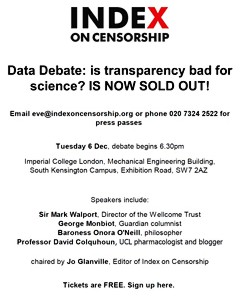
|
The meeting has been written up on the Bishop Hill Blog, with some very fine cartoon minutes.
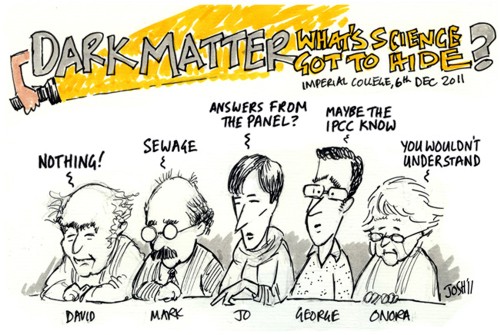 (I love the Josh cartoons -pity he seems to be a climate denier, spoken of approvingly by the unspeakable James Delingpole.)
(I love the Josh cartoons -pity he seems to be a climate denier, spoken of approvingly by the unspeakable James Delingpole.)
It was gratifying that my remarks seemed to be better received by the scientists in the audience than they were by some other panel members. The Bishop Hill blog comments "As David Colquhoun, the only real scientist there and brilliant throughout, said “Give them everything!” " Here’s a subsection of the brilliant cartoon minutes
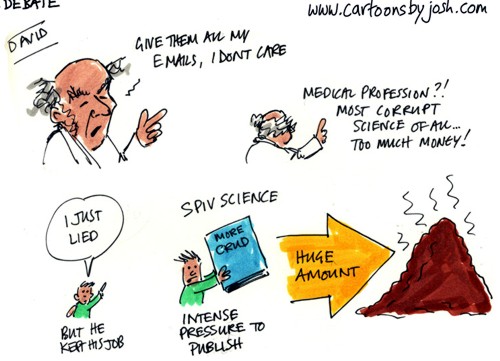
The bit about "I just lied -but he kept his job" referred to the notorious case of Richard Eastell and the University of Sheffield.
We all agreed that papers should be open for anyone to read, free. Monbiot and I both thought that raw data should be available on request, though O’Neill and Walport had a few reservations about that.
A great deal of time and money would be saved if data were provided on request. It shouldn’t need a Freedom of Information Act (FOIA) request, and the time and energy spent on refusing FOIA requests is silly. It simply gives the impression that there is something to hide (Climate scientists must be ruthlessly honest about data). The University of Central Lancashire spent £80,000 of taxpayers’ money trying (unsuccessfully) to appeal against the judgment of the Information Commissioner that they must release course material to me. It’s hard to think of a worse way to spend money.
A few days ago, the Department for Business, Innovation and Skills (BIS) published a report which says (para 6.6)
“The Government . . . is committed to ensuring that publicly-funded research should be accessible
free of charge.”
That’s good, but how it can be achieved is less obvious. Scientific publishing is, at the moment, an unholy mess. It’s a playground for profiteers. It runs on the unpaid labour of academics, who work to generate large profits for publishers. That’s often been said before, recently by both George Monbiot (Academic publishers make Murdoch look like a socialist) and by me (Publish-or-perish: Peer review and the corruption of science). Here are a few details.
Extortionate cost of publishing
Mark Walport has told me that
The Wellcome Trust is currently spending around £3m pa on OA publishing costs and, looking at the Wellcome papers that find their way to UKPMC, we see that around 50% of this content is routed via the “hybrid option”; 40% via the “pure” OA journals (e.g. PLoS, BMC etc), and the remaining 10% through researchers self-archiving their author manuscripts.
I’ve found some interesting numbers, with help from librarians, and through access to The Journal Usage Statistics Portal (JUSP).
Elsevier
UCL pays Elsevier the astonishing sum of €1.25 million, for access to its journals. And that’s just one university. That price doesn’t include any print editions at all, just web access and there is no open access. You have to have a UCL password to see the results. Elsevier has, of course, been criticised before, and not just for its prices.
Elsevier publish around 2700 scientific journals. UCL has bought a package of around 2100 journals. There is no possibility to pick the journals that you want. Some of the journals are used heavily ("use" means access of full text on the web). In 2010, the most heavily used journal was The Lancet, followed by four Cell Press journals
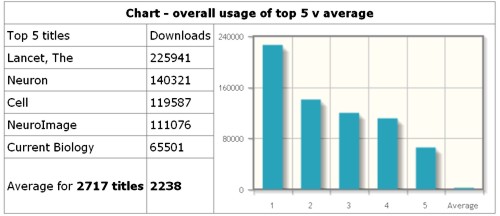
But notice the last bin. Most of the journals are hardly used at all. Among all Elsevier journals, 251 were not accessed even once in 2010. Among the 2068 journals bought by UCL, 56 were never accessed in 2010 and the most frequent number of accesses per year is between 1 and 10 (the second bin in the histogram, below). 60 percent of journals have 300 or fewer usages in 2010, Above 300, the histogram tails on up to 51878 accesses for The Lancet. The remaining 40 percent of journals are represented by the last bin (in red). The distribution is exceedingly skewed. The median is 187, i.e. half of the journals had fewer than 187 usages in 2010), but the mean number of usages (which is misleading for such a skewed distribution, was 662 usages).
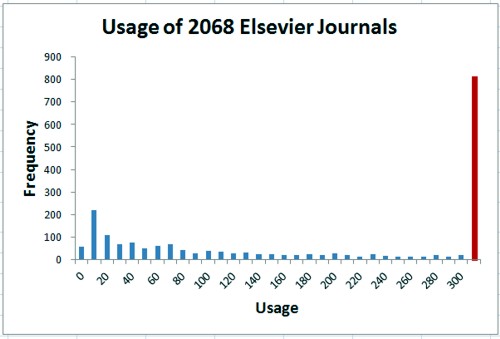
Nature Publishing Group
UCL bought 65 journals from NPG in 2010. They get more use than Elsevier, though surprisingly three of them were never accessed in 2010, and 17 had fewer than 1000 accesses in that year. The median usage was 2412, better than most. The leader, needless to say, was Nature itself, with 153,321.
Oxford University Press
The situation is even more extreme for 248 OUP journals, perhaps because many of the journals are arts or law rather than science.
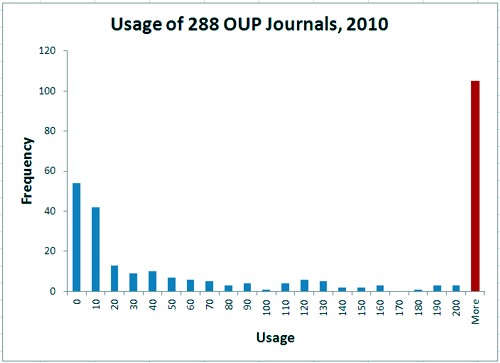
The most frequent (modal) usage of was zero (54 journals), followed by 1 to 10 accesses (42 journals) 64 percent of journals had fewer than 200 usages, and the 36 percent with over 200 are pooled in the last (red) bin. The histogram extends right up to 16060 accesses for Brain. The median number of usages in 2010 was 66.
So far I haven’t been able to discover the costs of the contracts with OUP or Nature Publishing group. It seems that the university has agreed to confidentiality clauses. This itself is a shocking lack of transparency. If I can find the numbers I shall -watch this space.
Almost all of these journals are not open access. The academics do the experiments, most often paid for by the taxpayer. They write the paper (and now it has to be in a form that is almost ready for publication without further work), they send it to the journal, where it is sent for peer review, which is also unpaid. The journal sells the product back to the universities for a high price, where the results of the work are hidden from the people who paid for it.
It’s even worse than that, because often the people who did the work and wrote the paper, have to pay "page charges". These vary, but can be quite high. If you send a paper to the Journal of Neuroscience, it will probably cost you about $1000. Other journals, like the excellent Journal of Physiology, don’t charge you to submit a paper (unless you want a colour figure in the print edition, £200), but the paper is hidden from the public for 12 months unless you pay $3000.
The major medical charity, the Wellcome Trust, requires that the work it funds should be available to the public within 6 months of publication. That’s nothing like good enough to allow the public to judge the claims of a paper which hits the newspapers the day that it’s published. Nevertheless it can cost the authors a lot. Elsevier journals charge $3000 except for their most-used journals. The Lancet charges £400 per page and Cell Press journals charge $5000 for this unsatisfactory form of open access.
Open access journals
The outcry about hidden results has resulted in a new generation of truly open access journals that are open to everyone from day one. But if you want to publish in them you have to pay quite a lot.
Furthermore, although all these journals are free to read, most of them do not allow free use of the material they publish. Most are operating under all-rights-reserved copyrights. In 2009 under 10 percent of open access journals had true Creative Commons licence.
Nature Publishing Group has a true open access journal, Nature Communications, but it costs the author $5000 to publish there. The Public Library of Science journals are truly open access but the author is charged $2900 for PLoS Medicine though PLoS One costs the author only $1350
A 2011 report considered the transition to open access publishing but it doesn’t even consider radical solutions, and makes unreasonably low estimates of the costs of open access publishing.
Scam journals have flourished under the open access flag
Open access publishing has, so far, almost always involved paying a hefty fee. That has brought the rats out of the woodwork and one gets bombarded daily with offers to publish in yet another open access journal. Many of these are simply scams. You pay, we put it on the web and we won’t fuss about quality. Luckily there is now a guide to these crooks: Jeffrey Beall’s List of Predatory, Open-Access Publishers.
One that I hear from regularly is Bentham Open Journals
(a name that is particularly inappropriate for anyone at UCL). Jeffery Beall comments
"Among the first, large-scale gold OA publishers, Bentham Open continues to expand its fleet of journals, now numbering over 230. Bentham essentially operates as a scholarly vanity press."
They undercut real journals. A research article in The Open Neuroscience Journal will cost you a mere $800. Although these journals claim to be peer-reviewed, their standards are suspect. In 2009, a nonsensical computer-generated spoof paper was accepted by a Bentham Journal (for $800),
What can be done about publication, and what can be done about grants?
Both grants and publications are peer-reviewed, but the problems need to be discussed separately.
Peer review of papers by journals
One option is clearly to follow the example of the best open access journals, such as PLoS. The cost of $3000 to 5000 per paper would have to be paid by the research funder, often the taxpayer. It would be money subtracted from the research budget, but it would retain the present peer review system and should cost no more if the money that were saved on extortionate journal subscriptions were transferred to research budgets to pay the bills, though there is little chance of this happening.
The cost of publication would, in any case, be minimised if fewer papers were published, which is highly desirable anyway.
But there are real problems with the present peer review system. It works quite well for journals that are high in the hierarchy. I have few grumbles myself about the quality of reviews, and sometimes I’ve benefitted a lot from good suggestions made by reviewers. But for the user, the process is much less satisfactory because peer review has next to no effect on what gets published in journals. All it influences is which journal the paper appears in. The only effect of the vast amount of unpaid time and effort put into reviewing is to maintain a hierarchy of journals, It has next to no effect on what appears in Pubmed.
For authors, peer review can work quite well, but
from the point of view of the consumer, peer review is useless.
It is a myth that peer review ensures the quality of what appears in the literature.
A more radical approach
I made some more radical suggestions in Publish-or-perish: Peer review and the corruption of science.
It seems to me that there would be many advantages if people simply published their own work on the web, and then opened the comments. For a start, it would cost next to nothing. The huge amount of money that goes to publishers could be put to better uses.
Another advantage would be that negative results could be published. And proper full descriptions of methods could be provided because there would be no restrictions on length.
Under that system, I would certainly send a draft paper to a few people I respected for comments before publishing it. Informal consortia might form for that purpose.
The publication bias that results from non-publication of negative results is a serious problem, mainly, but not exclusively, for clinical trials. It is mandatory to register a clinical trial before it starts, but many of the results never appear. (see, for example, Deborah Cohen’s report for Index on Censorship). Although trials now have to be registered before they start, there is no check on whether or not the results are published. A large number of registered trials do not result in any publication, and this publication bias can costs thousands of lives. It is really important to ensure that all results get published,
The ArXiv model
There are many problems that would have to be solved before we could move to self-publication on the web. Some have already been solved by physicists and mathematicians. Their archive, ArXiv.org provides an example of where we should be heading. Papers are published on the web at no cost to either user or reader, and comments can be left. It is an excellent example of post-publication peer review. Flame wars are minimised by requiring users to register, and to show they are bona fide scientists before they can upload papers or comments. You may need endorsement if you haven’t submitted before.
Peer review of grants
The problems for grants are quite different from those for papers. There is no possibility of doing away with peer review for the award of grants, however imperfect the process may be. In fact candidates for the new Wellcome Trust investigator awards were alarmed to find that the short listing of candidates for their new Investigator Awards was done without peer review.
The Wellcome Trust has been enormously important for the support of medical and biological support, and never more than now, when the MRC has become rather chaotic (let’s hope the new CEO can sort it out). There was, therefore, real consternation when Wellcome announced a while ago its intention to stop giving project and programme grants altogether. Instead it would give a few Wellcome Trust Investigator Awards to prominent people. That sounds like the Howard Hughes approach, and runs a big risk of “to them that hath shall be given”.
The awards have just been announced, and there is a good account by Colin Macilwain in Science [pdf]. UCL did reasonable well with four awards, but four is not many for a place the size of UCL. Colin Macilwain hits the nail on the head.
"While this is great news for the 27 new Wellcome Investigators who will share £57 million, hundreds of university-based researchers stand to lose Wellcome funds as the trust phases out some existing programs to pay for the new category of investigators".
There were 750 applications, but on the basis of CV alone, they were pared down to a long-list if 173. The panels then cut this down to a short-list of 55. Up to this point no external referees were used, quite unlike the normal process for award of grants. This seems to me to have been an enormous mistake. No panel, however distinguished, can have the knowledge to distinguish the good from the bad in areas outside their own work, It is only human nature to favour the sort of work you do yourself. The 55 shortlisted people were interviewed, but again by a panel with an even narrower range of expertise, Macilwain again:
"Applications for MRC grants have gone up “markedly” since the Wellcome ones closed, he says: “We still see that as unresolved.” Leszek Borysiewicz, vice-chancellor of the University of Cambridge, which won four awards, believes the impact will be positive: “Universities will adapt to this way of funding research."
It certainly isn’t obvious to most people how Cambridge or UCL will "adapt" to funding of only four people.
The Cancer Research Campaign UK has recently made the same mistake.
One problem is that any scheme of this sort will inevitably favour big groups, most of whom are well-funded already. Since there is some reason to believe that small groups are more productive (see also University Alliance report), it isn’t obvious that this is a good way to go. I was lucky enough to get 45 minutes with the director of the Wellcome Trust, Mark Walport, to put these views. He didn’t agree with all I said, but he did listen.
One of the things that I put to him was a small statistical calculation to illustrate the great danger of a plan that funds very few people. The funding rate was 3.6% of the original applications, and 15.6% of the long-listed applications. Let’s suppose, as a rough approximation, that the 173 long-listed applications were all of roughly equal merit. No doubt that won’t be exactly true, but I suspect it might be more nearly true than the expert panels will admit. A quick calculation in Mathcad gives this, if we assume a 1 in 8 chance of success for each application.
Distribution of the number of successful applications
Suppose $ n $ grant applications are submitted. For example, the same grant submitted $ n $ times to selection boards of equal quality, OR $ n $ different grants of equal merit are submitted to the same board.
Define $ p $ = probability of success at each application
Under these assumptions, it is a simple binomial distribution problem.
According to the binomial distribution, the probability of getting $ r $ successful applications in $ n $ attempts is
\[ P(r)=\frac{n!}{r!\left(n-r\right)! }\; {p}^{r} \left(1-p \right)^{n-r} \]
For a success rate of 1 in 8, $ p = 0.125 $, so if you make $ n = 8 $ applications, the probability that $ r $ of them will succeed is shown in the graph.
Despite equal merit, almost as many people end up with no grant at all as almost as many people end up with no grant at all as get one grant. And 26% of people will get two or more grants.
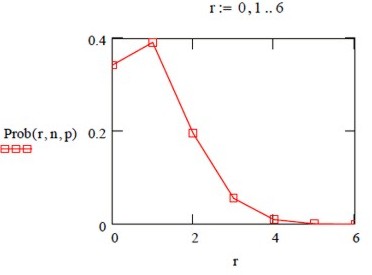
Of course it would take an entire year to write 8 applications. If we take a more realistic case of making four applications we have $ n = 4 $ (and $ p = 0.125 $, as before). In this case the graph comes out as below. You have a nearly 60% chance of getting nothing at all, and only a 1 in 3 chance of getting one grant.
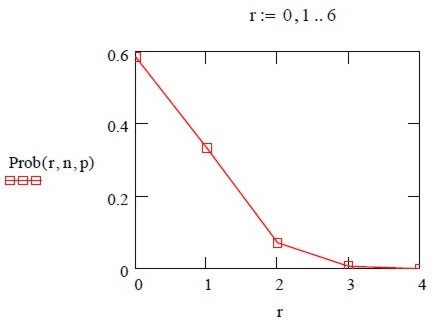
These results arise regardless of merit, purely as consequence of random chance. They are disastrous, and especially disastrous for the smaller, better-value, groups for which a gap in funding can mean loss of vital expertise. It also has the consequence that scientists have to spend most of their time not doing science, but writing grant applications. The mean number of applications before a success is 8, and a third of people will have to write 9 or more applications before they get funding. This makes very little sense.
Grant-awarding panels are faced with the near-impossible task of ranking many similar grants. The peer review system is breaking down, just as it has already broken down for journal publications.
I think these considerations demolish the argument for funding a small number of ‘stars’. The public might expect that the person making the application would take an active part in the research. Too often, now, they spend most of their time writing grant applications. What we need is more responsive-mode smallish programme grants and a maximum on the size of groups.
Conclusions
We should be thinking about the following changes,
- Limit the number of papers that an individual can publish. This would increase quality, it would reduce the impossible load on peer reviewers and it would reduce costs.
- Limit the size of labs so that more small groups are encouraged. This would increase both quality and value for money.
- More (and so smaller) grants are essential for innovation and productivity.
- Move towards self-publishing on the web so the cost of publishing becomes very low rather than the present extortionate costs. It would also mean that negative results could be published easily and that methods could be described in proper detail.
The entire debate is now on YouTube.
Follow-up
24 January 2012. The eminent mathematician, Tim Gowers, has a rather hard-hitting blog on open access and scientific publishing, Elsevier – my part in its downfall. I’m right with him. Although his post lacks the detailed numbers of mine, it shows that mathematicians has exactly the same problems of the rest of us.
11 April 2012. Thanks to Twitter, I came across a remarkably prescient article, in the Guardian, in 2001.
Science world in revolt at power of the journal owners, by James Meek. Elsevier have been getting away with murder for quite a while.
19 April 2012.
|
I got invited to give after-dinner talk on open access at Cumberland Lodge. It was for the retreat of out GEE Department (that is the catchy brand name we’ve had since 2007: I’m in the equally memorable NPP). I think it stands for Genetics, Evolution and Environment. The talk seemed to stiir up a lot of interest: the discussions ran on to the next day. |

|
It was clear that younger people are still as infatuated with Nature and Science as ever. And that, of course is the fault of their elders.
The only way that I can see, is to abandon impact factor as a way of judging people. It should have gone years ago,and good people have never used it. They read the papers. Access to research will never be free until we think oi a way to break the hegemony of Nature, Science and a handful of others. Stephen Curry has made some suggestions
Probably it will take action from above. The Wellcome Trust has made a good start. And so has Harvard. We should follow their lead (see also, Stephen Curry’s take on Harvard)
And don’t forget to sign up for the Elsevier boycott. Over 10,000 academics have already signed. Tim Gowers’ initiative took off remarkably.
24 July 2012. I’m reminded by Nature writer, Richard van Noorden (@Richvn) that Nature itself has written at least twice about the iniquity of judging people by impact factors. In 2005 Not-so-deep impact said
"Only 50 out of the roughly 1,800 citable items published in those two years received more than 100 citations in 2004. The great majority of our papers received fewer than 20 citations."
"None of this would really matter very much, were it not for the unhealthy reliance on impact factors by administrators and researchers’ employers worldwide to assess the scientific quality of nations and institutions, and often even to judge individuals."
And, more recently, in Assessing assessment” (2010).
27 April 2014
The brilliant mathematician,Tim Gowers, started a real revolt against old-fashioned publishers who are desperately trying to maintain extortionate profits in a world that has changed entirely. In his 2012 post, Elsevier: my part in its downfall, he declared that he would no longer publish in, or act as referee for, any journal published by Elsevier. Please follow his lead and sign an undertaking to that effect: 14,614 people have already signed.
Gowers has now gone further. He’s made substantial progress in penetrating the wall of secrecy with which predatory publishers (of which Elsevier is not the only example) seek to prevent anyone knowing about the profitable racket they are operating. Even the confidentiality agreements, which they force universities to sign, are themselves confidential.
In a new post, Tim Gowers has provided more shocking facts about the prices paid by universities. Please look at Elsevier journals — some facts. The jaw-dropping 2011 sum of €1.25 million paid by UCL alone, is now already well out-of-date. It’s now £1,381,380. He gives figures for many other Russell Group universities too. He also publishes some of the obstructive letters that he got in the process of trying to get hold of the numbers. It’s a wonderful aspect of the web that it’s easy to shame those who deserve to be shamed.
I very much hope the matter is taken to the Information Commissioner, and that a precedent is set that it’s totally unacceptable to keep secret what a university pays for services.
A momentous decision was promulgated (as lawyers say) by the Information Tribunal on December 8th 2009. It marks a step forward in Freedom of Information about how universities spend your money. It has taken 3.5 years to get to this point. Perhaps now there will be an end to the attempts of every single university that I’ve
approached to conceal what they teach.
Decision
"The Tribunal upholds the decision notice dated 30th. March, 2009, dismisses the appeal and directs that all the steps required by the Decision Notice be taken within 28 days of the date of this Decision"
Back story for this case
24th July 2006. I asked the University of Central Lancashire (UCLAN) for copies of teaching materials and validation documents for their "BSc" degree in homeopathy (this degree no longer exists: it was abolished in 2008). A year later, UCLAN shut the rest of its courses in alternative medicine, after an internal review.
21 August 2006. I was sent the validation documents but refused the teaching materials as UCLAN claimed they were exempt under section 43(2) of the Freedom of Information Act (FOIA)(commercial interests). Two days later I sent a request for the mandatory internal review of the refusal.
4th October 2006. The internal review confirmed the original decision (it always does), and cited, as well as section .43(2) of FOIA, section 21.
21 October 2006. I appealed to the Information Commissioner. The basis of the appeal was that the university might have financial interests in the outcome, but not commercial interests, because universities are not commercial organisations as defined in section 43(2) of the FOIA. In addition, even if the commercial argument was not allowed, the public interest in knowing what was taught was sufficient to justify release of the requested materials.
21 January 2008. The Information Commissioner finally got round to starting on the case.
29 September 2008 The vice-chancellor, Malcolm McVicar, raised an objection to complying with my request under s.36(2)(c) of FOIA. This states that “In the reasonable opinion of a qualified person, disclosure of the information under this Act” “(c) would otherwise prejudice, or would be likely otherwise to prejudice, the effective conduct of public affairs..”
30 March 2009. The decision of the Information Commissioner was published. It has already been described here. Apart from one trivial matter, my appeal was upheld, and UCLAN was ordered to release the requested material within 35 days. However UCLAN did not release the material, but rather launched an appeal against the Information Commissioner. The appeal was heard by an Information Tribunal.
The full text of the Freedom of Information Act is here.
The Information Tribunal
The Tribunal heard the case of University of Central Lancashire v Information Commissioner in Manchester on November 3, 4 and 5. I was an ‘additional party’ to the proceedings and attended in person for the first two days, with the aim of helping the Information Commissioner’s case. This is what the tribunal looked like.
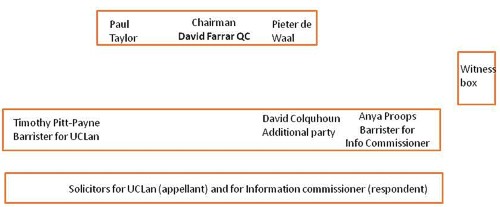
I was amazed to find myself sitting next to the barrister for the Information Commisioner, and still more amazed to be invited to cross-question the witnesses, after she had questioned them.
The witnesses were Malcom McVicar (vice-chancellor of UCLAN), Peter Hyett, (executive director of finance at UCLAN) and David Phoenix (Deputy vice-chancellor, UCLAN).
The outcome
The decision in full can be read here.
|
Decision The Tribunal upholds the decision notice dated 30th. March, 2009, dismisses the appeal and directs that all the steps required by the Decision Notice be taken within 28 days of the date of this Decision. |
So we won.
The details of the decision contain some matters of great interest for universities, in particular the dismissal of the idea that the public can be reassured by either internal or external (e.g. QAA) validation procedures. I’ll try to summarise them (paragraph numbering as in the decision
notice).
Commercial interests
The one disappointing thing about the Tribunal’s decision was that it contradicted the Information Commissioner’s decision on the meaning of commercial interests.
31 "Therefore, whether on a broad or narrow construction of the statutory words, we are satisfied that UCLAN `s interests in teaching material produced for its degree courses are properly described as “commercial”.
However, that does not affect the outcome because the Tribunal decided that there was no reason to think that the course materials actually had the commercial value that UCLAN said they did. For
example:
36 We were not impressed by the claim that third parties with copyright in the disclosed materials would be alienated by UCLAN `s compliance with a decision that this information must be provided. None gave evidence to that effect.
37 It was not clear to us how a competitor could significantly exploit access to this material, without infringing UCLAN `s copyright or brazenly aping the content of a course, which would surely attract the scorn of the wider academic community. Moreover, it seemed to us likely that most potential students would be attracted to a particular course by the reputation of the teaching staff and a range of extra – curricular factors at least as much as by a comparative study of the powerpoint presentations and notes provided to current students.
and
39 Finally, in this particular case, we doubt whether this course had a significant commercial value, given the limited enrolment and the virtual absence of overseas interest.
At this point, the appeal is essentially dismissed. Nevetheless, the Tribunal went on to discuss the other defences offered by UCLAN, and some of their conclusions are more interesting than the subtle distinction between ‘financial interests’ and ‘commercial interests’.
40 In the light of this finding, it is not strictly necessary to decide the balance of public interest as to disclosure. Nevertheless, since the issue has been carefully and very fully argued, we shall shortly indicate our view, had the likelihood of prejudice been established.
Public Interest
The commercial interest defence is subject to the public interest argument in s.1(2((b) of the FOIA’
(b) in all the circumstances of the case, the public interest in maintaining the exclusion of the duty to confirm or deny outweighs the public interest in disclosing whether the public authority
holds the information.
Hence, the decision notice says
41 As ever, the question is whether the public interest in maintaining the exemption outweighs the interest in disclosure.
On the question of public interest, the Tribunal comes down strongly on the side of the Commissioner and me.
46 The public interest in disclosure seems to us appreciably stronger. Apart from the universal arguments about transparency and the improvement of public awareness, we find that there are particular interests here, arising from the nature of a university and the way it is funded.
It is particularly interesting that the Tribunal dismissed the role of internal and external validation as a substitute for transparency. As part of their case (para 18) UCLAN had argued
"Moreover, standards were ensured by the validation procedures which were required before a course was launched and which involved independent expert external monitors and by quality assurance (Q.A.A.) which demands a continuing compliance with national standards."
This cut no ice with the Tribunal. In one of his few direct interjections the Tribunal Chairman, David Farrar Q.C., questioned a witness directly about the internal validation processes, Evidently he was not impressed by the answers. During my own cross questioning of the deputy vice-chancellor, I put to him the view that since the QAA [Quality Assurance Agency] was not allowed to take any notice of the content of courses, that getting a high mark from the QAA was not a substitute for seeing what was actually taught. The deputy vice-chancellor did not seem to disagree strongly with that view.
47 First, the public has a legitimate interest in monitoring the content and the academic quality of a course, particularly a relatively new course in a new area of study, funded, to a very significant extent, by the taxpayer. It is no answer, we consider, to say that this function is performed by the process of validation or the continuing monitoring of standards with external input. Whether or not these processes are conducted with critical rigour, it must be open to those outside the academic community to question what is being taught and to what level in our universities. The apparent perception in some quarters that the intellectual demands of some or many degree courses have been relaxed, that higher classes of degree are too lightly earned, may be largely or entirely unfounded. But it is highly important that the material necessary to a fair judgement be available. That material will often, if not always, include the basic content of the course, such as is requested here.
48 Secondly, this is especially the case where, as with the BSc. (Homeopathy), there is significant public controversy as to the value of such study within a university. In this case, that factor standing alone would have persuaded us that the balance of public interest favoured disclosure.
49 We are not attracted by the somewhat patrician argument that the general public, uninstructed in the specialist subject under scrutiny, would be incapable of forming a proper judgement. That might be so, were it impossible to seek independent expertise to assist in making an assessment. Happily, it is not.
50 Finally, there is a public interest in opening up new methods of teaching and new insights as to the content of courses, so as to stimulate the spread of good practice.
So, a hands down win on the public interest argument.
Prejudice to effective conduct of public affairs
I found incomprehensible the argument that disclosure would ‘prejudice the effective conduct of public affairs’. But it was raised (at the last minute) by UCLAN, and it was considered by the Tribunal. This defence refers to s.36(2)(c) of FOIA. It states that “In the reasonable opinion of a qualified person, disclosure of the information under this Act” “(c) would otherwise prejudice, or would be likely otherwise to prejudice, the effective conduct of public affairs..”
As noted at paragraph 17, it is common ground, established as to (iii), by the jurisprudence of the Tribunal, that this exemption is engaged if three requirements are met. They can be shortly labelled
(i) qualified person
(ii) reasonable opinion
(iii) reasonably arrived at.
The Tribunal seemed to be distinctly unimpressed by the arguments presented by UCLAN.
56 A reasonable opinion may be one with which the Tribunal emphatically disagrees, provided it is based on sound argument and evidence. With great respect to Professor McVicar, whose sincerity is not in question, we can find no adequate evidential basis for this opinion and consider that it rests on two misconceptions as to the application of FOIA. We do not find that it passes the required test of objective reasonableness.
57 We considered separately whether the opinion was reasonably arrived at. Again, our answer is no.
58 Section 36 provides for an exceptional exemption which the public authority creates by its own action, albeit subject to scrutiny of its reasonableness, the likelihood of prejudice and the question of the public interest. That factor of itself justifies a requirement that the authority provide substantial evidence as to the advice (other than legal advice) and the arguments presented to the qualified person upon which his opinion was founded. We emphasise that no set formula is required, just a simple clear record of the process.
59 The need for such evidence is all the greater where, as here, the authority invokes s.36 for the first time after the complaint to the IC [Information Commissioner].
60 The evidence consists of a briefly argued email from Dr. Bostock suggesting that s.36(2)(c) be invoked on the very broadly argued grounds already reviewed. The tone implicitly acknowledges that the claim is rather speculative. We are not concerned with the slightly uncertain use of possibility and likely but the impression left is of a last minute idea, not really thought through or investigated
but merely discussed with solicitors to tie it in to the FOIA. It was sent to the Vice Chancellor at 3.20pm. on a Friday afternoon, 26th. September, 2008, asking for the Vice Chancellor’s agreement. That agreement was forthcoming in a single sentence without further comment in an email reply timed at 12.05pm.on the following Monday.61 We find that the process of forming the necessary opinion was, to say the least, perfunctory, indeed far short of the careful assessment and investigation that normally supports a qualified opinion for the purposes of s.36.
62 Accordingly, we do not find that it was reasonably arrived at.
Conclusion
62 It is for these reasons that we uphold the Decision Notice. We record our gratitude for the helpful and succinct submissions of counsel on both sides and the incisive contribution of Professor Colquhoun. We wish to add that, whilst we have not accepted the great majority of the arguments advanced by UCLAN, we do not in any way seek to cast doubt on the veracity of the evidence of its witnesses, nor the honesty and loyalty with which they have sought to serve its interests.
63 Our decision is unanimous.
Signed David Farrar Q.C.
Watch this space to see what can now be revealed.
